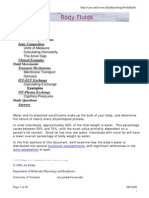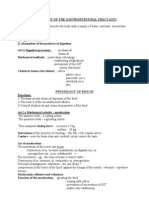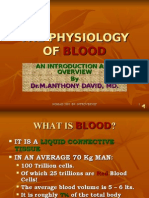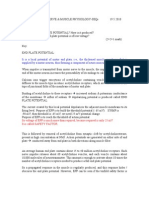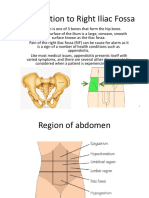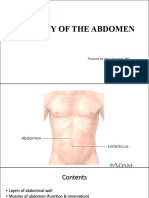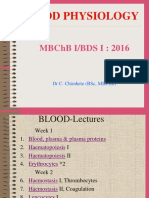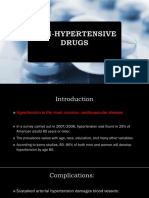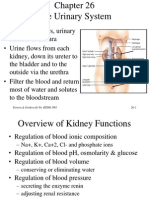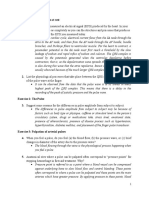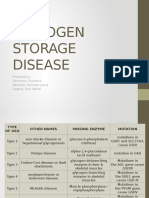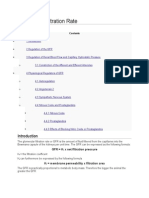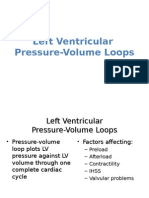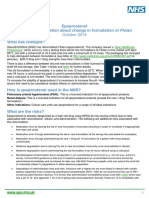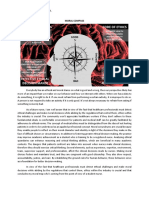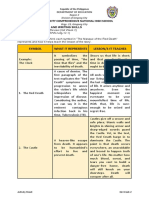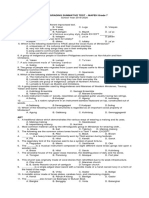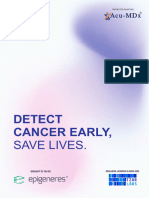Overview of Cardiovascular System: An Introduction To Chapters 9 - 24 and Chapter 36 Guyton and Hall, 12 Edition
Overview of Cardiovascular System: An Introduction To Chapters 9 - 24 and Chapter 36 Guyton and Hall, 12 Edition
Uploaded by
bahahahahCopyright:
Available Formats
Overview of Cardiovascular System: An Introduction To Chapters 9 - 24 and Chapter 36 Guyton and Hall, 12 Edition
Overview of Cardiovascular System: An Introduction To Chapters 9 - 24 and Chapter 36 Guyton and Hall, 12 Edition
Uploaded by
bahahahahOriginal Title
Copyright
Available Formats
Share this document
Did you find this document useful?
Is this content inappropriate?
Copyright:
Available Formats
Overview of Cardiovascular System: An Introduction To Chapters 9 - 24 and Chapter 36 Guyton and Hall, 12 Edition
Overview of Cardiovascular System: An Introduction To Chapters 9 - 24 and Chapter 36 Guyton and Hall, 12 Edition
Uploaded by
bahahahahCopyright:
Available Formats
Overview of Cardiovascular System
An Introduction to Chapters 9 24 and Chapter 36 Guyton and Hall, 12th Edition
Brian M. Matayoshi, Ph.D. I. Introduction: These first few introductory hours of the Human Physiology Course are dedicated to presenting a general physiological overview of the cardiovascular system. We will discuss system function as a whole, break down the component parts so that we can specify the purpose and function of each component and finally summarize by discussing a model of organization which will be useful for analyzing overall function, determining system efficiency, and explaining clinical deficiency as an exercise in the application of the material. Because structure determines functional efficiency and limitations, the student is expected to review the anatomic (both micro and macro) and developmental details of the heart before we continue with the specific lectures on cardiac mechanics. A. Purpose The purpose of this overview is to introduce to the student the general function of each part of the system and to identify the relevant parameters that are important to the understanding of the major mechanisms of action. The lecture is designed so that the student can book mark these ideas for future reference as we progress through the specific lectures in the course and also provides a conceptual framework for linking physiologic function, parameters and mechanisms to the understanding of clinical manifestations of a patient condition. Objectives The student should be able to: 1. Recall from memory bolded items and give their definitions. 2. Identify as important the bolded ideas when they are covered in future sessions and recognize them as testable items. 3. List the temporal and functional sequence of events for the delivery of blood to and from the heart and the transport of import components to and from cells and tissues. 4. List the major functions of each part of the cardiovascular system. 5. Identify the important equations, normal values, constants, terms, abbreviations, concepts and structure relationships as testable for future reference.
B.
II.
The cardiovascular system, structurally, is a closed, parallel-series sequence of pipes with a pulsatile pump. Its function is to deliver the total amount of blood and its components needed to the tissues, distribute it to each specific tissue area based on need (nutrient need and waste removal) and then to return what remains back to the heart. A. The Heart A Muscular Pump 1. Consists of two atria and two ventricles containing cardiac muscle, specialized muscle fibers (conduction pathways and nodes) and connective tissue coverings. The heart is innervated at both the nodes and muscle (By what systems and nerves?). 1
a.
Pulsatile, two stroke pump. Why is this idea important relative to the control of pumping blood?
b.
Each pair of atrium and ventricle is a separate pump. i. Right pair pumps to the lower pressure pulmonary system. ii. Left pair pumps to the higher pressure systemic circulation. Why are these two ideas important in the understanding of clinical manifestations?
iii.
Normally the left ventricular wall is thicker because it must pump against the greater pressure within the systemic circulation (a function of the total peripheral resistance, TPR) A) This resistance can also be synonymous with the afterload. Is this how afterload is defined or is there a more specific definition? If so, what is it?
B)
In the fetus, the right and left ventricular walls have nearly equal thickness due to the high pulmonary vascular resistance or right ventricular afterload. (How does this high resistance occur given what we have already said about low pulmonary pressures?). Hint: are the lungs inflated or deflated?
2.
The heart controls the total amount of blood delivered to the entire system. How? a. This amount is given in volume per unit time and is called cardiac output (CO). i. The units are liters or mls./minute. ii. The normal value is approximated as 5L./minute, although the young healthy male is said to average around 5.6L/minute. b. Normally the cardiac output of both left and right sides of the heart is approximately (within normal compensatory parameters) equal.
i.
This phenomena is due to the fact that the pulmonary and systemic circulations are relatively separate. The exception is that normally about 2% of the cardiac output, which goes to the bronchial arteries, returns to the heart via the pulmonic vein. Thus, this blood is said to be shunted. What specific type of shunt is this situation an example of? What is the result of this shunt? What does all this have to do with the term venous admixture?
ii.
Any variation in the amounts of blood returning to the right heart (called the venous return) and the left heart is balanced though the intrinsic regulation of the hearts mechanical pumping (The Frank-Starling Mechanism). How is this mechanism explained on the level of the muscle cell?
c.
The cardiac output of both the left and right heart can be determined by the Cardiac Output Equation. i. CO = HR X SV (HR= heart rate in beats/minute (bpm), and SV = stroke volume in milliliters or liters) ii. HR is a measure of the number of times the heart beats (strokes) in a minute. How can this parameter be measured clinically? A) Increase in heart rate to a point increase CO. Why?
B)
However, very high heart rates can reduce CO. High heart rates reduce the amount of time the ventricle has to fill with blood (filling time) and thus reduces the amount of blood that can be ejected per stroke (SV). If the volume of blood that has filled the ventricle prior to ejection (referred to as end diastolic volume) is severely reduced, SV is reduced and CO can be reduced or at very least, the efficiency of pumping a given volume of blood per minute is reduced. Why? (BE CAREFUL!!!
There are multiple consideration here that have clinical relevance. Can you identify them?)
iii.
Stroke volume is the amount of blood ejected per contraction (the contracted state is called systole vs. the relaxed state which is called diastole). A) Stroke volume is determined by a combination of filling (end diastolic volume (EDV) or preload .. is this really preload or just synonymous with the term. What is the real definition and origin of the term preload?), the contractility (the ability of the heart to contract. How is this idea really determined and defined?) and the afterload. Can you explain in simple physical terms why these three parameters determine SV?
B)
Contractility is difficult to absolutely quantify. Why? Conditions that positively increase the force of contraction (called positive inotropism) increase contractility and conditions which decrease the force of contraction (called negative inotropism) decrease contractility. Can you suggest how these conditions or stimuli can increase or decrease contractility? How is contractility most accurately defined? What would you call conditions that change HR?
C)
One common way to indirectly examine contractility (used clinically) is to determine ejection fraction (EF). The ejection fraction is the % of blood that is ejected per stroke. In other
words, if you take the amount of blood ejected (which is determined by subtracting the end systolic volume (ESV) from the end diastolic volume (EDV) to get the SV, and then divide the SV by the amount of blood you started with (EDV.. do you see this idea?) multiplied by 100 gives you the EF. Write the equation below to demonstrate your understanding. What clinical methods might be used to determine ejection fraction?
d.
Since the heart is a muscle, can the mechanical activity be related to its electrical activity? Be careful to analyze all aspects of this question as understanding it is a key point in understanding how one clinically evaluates cardiac deficiency! i. The cardiac action potential there are different types A) Nodes (pacemakers and auto-rhythmicity) B) Conduction pathway cells C) Atrial muscle D) Ventricular muscle ii. Electrocardiogram (EKG) A) What is this device? B) How does it work? C) Who is Einthoven? D) What is Einthovens Triangle and what does it have to do with EKG? E) How do individual cardiac action potentials compare/relate to the P, QRS, T normal EKG pattern?
3.
What are the criteria for determining the amount of blood pumped? a. Blood flow to each tissue is determined by tissue need. b. CO is determined and controlled by the sum total of all local tissue blood flows. What role does venous return play in the control of cardiac output? Why is this the case? What does this have to do with Frank-Starling? c. Afterload, is mostly independently regulated via the vascular system. Why is this idea important relative to system function from a practical standpoint?
B.
The arteries act as the delivery system and regulation of blood flow to each region area occurs at this level. 1. Controls delivery of blood to each part of the body a. Regulation of distribution is accomplished through vasodilation and vasoconstriction. b. Vasodilation enhances flow to the tissue by reducing the pathway (vascular) resistance to it. c. Vasoconstriction reduces flow to the tissue by increasing the pathway (vascular) resistance to it.
2.
Resistance is the key concept here. a. Vasoconstriction increases vessel resistance and reduces vessel wall compliance (the ease at which the vessel can stretch). Increasing resistance decreases flow if the Driving Force (which is measured as pressure) remains constant. Vasodilation has the opposite affect. Can you define compliance mathematically? Can you describe the relationship between flow, force and resistance given above, mathematically?
b.
The relationship between flow, driving force, and resistance is described by a shortened form of Poiseuilles Law called the flow equation: Q = P/R. i. Q = Flow ii. P = the change in pressure over the distance the flow is measured. It is a measure of the driving force over a distance and can be calculated by subtracting the pressures at the two end points. iii. R = resistance to flow over that distance. Resistance to flow at any point is directly related to the pressure at that point but in the real sense resistance is not measured but rather calculated. Can you explain why? A) Does flow occur in the direction from high pressure to low pressure all the time? B) How does a change in the vessel diameter or radius affect resistance, pressure and flow? iv. Finally, does the fluid (in this case blood) itself play a role in flow? A) There are two types of flow. 1) Laminar flow
2)
Turbulent flow
B)
How are these two types of flow defined? What can cause or favor one flow type over the other? 1) Ideal or Newtonian Fluid
2)
Reynolds number
3)
Viscosity Poiseuilles Law
4)
5)
Hint: See Chapter 14 and the internet for the listed items.
C.
The veins storage component 1. Compliance is the key idea here. a. Refers to the ease of stretch. b. Compliance is the opposite of elasticity. Elasticity refers to the ability to rebound. c. Veins are more compliant and arteries are more elastic. What is the structural reason for this difference? 2. Constriction of the venous system has very little effect on TPR. Why is this true when constriction of the arteries immediately increases TPR significantly? a. Constriction of the venous system increases venous return (VR) and thereby increases cardiac filling. Why is this true?
b.
Venous dilation decreases filling and venous return. Why?
i.
What are varicose veins?
ii.
What affect does varicosities have on filling and venous return?
iii.
What are the general structures and mechanisms that enhance the venous return function of the veins?
3.
Parameters and terms to know Compare the arterial and venous system for major similarities and differences. See if you can explain these similarities and differences based on structure-function relationships. Identify any other relevant terms.
D.
The blood is responsible for gas and nutrient/waste delivery and removal, other transport and hemostasis. 1. What is the composition of blood? (A review will be given later this week so be sure to pay attention!) a. Cellular b. Biomolecular c. Fluid d. How are these items related to the characteristics of fluid flow and how may this be clinically relevant?
2.
Functions (Create a list with the help of your book) a. Distribution i. Delivery of oxygen and nutrients ii. Transport and removal of carbon dioxide and other metabolic waste. iii. Transport of cellular signals iv. Transport of cellular components and holding area for regulatory enzymes and other substances. b. Regulation i. Maintenance of body temperature ii. Maintenance of pH
3.
Maintenance of circulatory, interstitial, and intracellular fluid and solute balance. c. Preventative i. Blood loss (clotting) A) Coagulation cascade B) Platelets ii. Host defense Here are some important normal values to know for now What others should you learn and how should you know to add other similar facts? a. Hematocrit = 40 to 45%, RBCs 4 to 6 million per ul. b. 1.34 mls. of oxygen bound to 1 gram of Hb c. 15 g of Hb per 100mls of blood d. 20.1mls of oxygen per 100mls. of blood or 20 volume% e. PaO2 = 95 mm Hg f. PvO2 = 40 mm Hg g. PaCO2 = 40 mm Hg h. PvCO2 = 45 mm Hg i. PAO2 = 104 mm Hg j. PACO2 = 40 mm Hg Area of exchange capillaries a. How does the exchange occur? i. Paracellular ii. Transcellular iii. Bulk Flow iv. Ultrafiltration v. Diffusion vi. Osmosis vii. Pinocytosis/endocytosis viii. You should already know the terms listed above. b. Identify and list the driving forces that are involved on an appropriate diagram. Write the capillary filtration (Starlings) equation and define each component giving normal values for each across the vascular periphery, the lungs and the kidney glomerulus. c. Removal of the interstitial fluid The lymphatics and the microcirculation. i. Starling parameters hydrostatic and oncotic pressures. ii. Venous mechanisms iii. Major lymphatic pathways back to the blood.
iii.
4.
III.
Lecture Summary A. What are the temporal and functional sequence of events that occur as the heart pumps blood to the peripheral tissues and the blood returns to the heart? B. What important parameters dictate control of the system?
C.
D. E. IV.
1. Oxygen need 2. Global pressure Key feed back systems 1. Local 2. Neural and hormonal How is homeostasis maintained across the cardiovascular system? This model that can help you remember and analyze these ideas.
An introduction to atrial and ventricular cycles, cardiac pumping mechanics and the Cardiac Cycle.
10
You might also like
- K Sembulingam - Essentials of Medical Physiology, 6th EditionDocument14 pagesK Sembulingam - Essentials of Medical Physiology, 6th EditionZammam Hashim MecciNo ratings yet
- Water LoseDocument29 pagesWater LoseJAKLIN EMPOLNo ratings yet
- Group Medical Appointments: An Introduction for Health ProfessionalsFrom EverandGroup Medical Appointments: An Introduction for Health ProfessionalsRating: 5 out of 5 stars5/5 (1)
- ADULT HEALTH NURSING-2 INCLUDING GERIATRIC NURSING (Syllabus)Document4 pagesADULT HEALTH NURSING-2 INCLUDING GERIATRIC NURSING (Syllabus)Abhishek NaharNo ratings yet
- Pediatric History TemplateDocument3 pagesPediatric History TemplateJoel TamayoNo ratings yet
- Practical PhysiologyDocument436 pagesPractical Physiologyaastha212002100% (1)
- Physiology of The Gastrointestinal Tract (Git)Document98 pagesPhysiology of The Gastrointestinal Tract (Git)jballungayNo ratings yet
- Shock and Circulatory FailureDocument8 pagesShock and Circulatory FailureOktaviana Sari DewiNo ratings yet
- Cvs Adjustments During Exercise by DR Sadia ZafarDocument23 pagesCvs Adjustments During Exercise by DR Sadia ZafarMudassar RoomiNo ratings yet
- Uman Hysiology: Integrative Physiology III: ExerciseDocument23 pagesUman Hysiology: Integrative Physiology III: ExercisepaskalinaNo ratings yet
- Nerve and Muscle PhysiologyDocument82 pagesNerve and Muscle PhysiologychandsriNo ratings yet
- Physiology Notes Semester 1Document84 pagesPhysiology Notes Semester 1Daniel Li100% (1)
- Nerve Physiology 1718 PracticalDocument18 pagesNerve Physiology 1718 PracticalMichael TobilobaNo ratings yet
- The Physiology of BloodDocument41 pagesThe Physiology of BloodDr.M.Anthony David100% (10)
- PSG 252 Lecture 3 The StomachDocument5 pagesPSG 252 Lecture 3 The StomachMichael TobilobaNo ratings yet
- CH 1 - PT 1Document60 pagesCH 1 - PT 1noureen100% (1)
- 09 Endocrine System PhysiologyDocument43 pages09 Endocrine System PhysiologyKaye Alyssa Enriquez100% (1)
- NERVE & MUSCLE 45 Qs With Their Answer Keys by Dr. RoomiDocument54 pagesNERVE & MUSCLE 45 Qs With Their Answer Keys by Dr. RoomiMudassar Roomi100% (1)
- Body Fluids and ElectrolytesDocument42 pagesBody Fluids and ElectrolytesQusaiBadr100% (1)
- Seminar 4Document49 pagesSeminar 4Yamuna SubramaniamNo ratings yet
- Drug Heart Failure MDocument24 pagesDrug Heart Failure MAthari Khan100% (1)
- Anatomy of The AbdomenDocument107 pagesAnatomy of The AbdomenmichaelhossianNo ratings yet
- DuodenumDocument47 pagesDuodenumAarish KanwatNo ratings yet
- DR Jagdish Narayan Assistant Professor Department of PhysiologyDocument75 pagesDR Jagdish Narayan Assistant Professor Department of PhysiologyYordanos GetachewNo ratings yet
- Anatomy of The ThighDocument43 pagesAnatomy of The ThighShiv SharmaNo ratings yet
- Cardiac OutputDocument37 pagesCardiac OutputIndrashish Chakravorty100% (1)
- PhysiologyDocument31 pagesPhysiologyraza20100% (1)
- Q. List Different Functions of The Kidney: (A) Homeostatic FunctionDocument42 pagesQ. List Different Functions of The Kidney: (A) Homeostatic Functionramadan100% (4)
- Renal PhysiologyDocument129 pagesRenal PhysiologynehaNo ratings yet
- Physiology of The Cardiovascular System-CVSDocument56 pagesPhysiology of The Cardiovascular System-CVSAmanuel MaruNo ratings yet
- Anatomy Best Short Notes and Flow ChartDocument5 pagesAnatomy Best Short Notes and Flow ChartNikhilNo ratings yet
- Chapter 70-GuytonDocument9 pagesChapter 70-Guytonswoljaswol1No ratings yet
- Development of HeartDocument15 pagesDevelopment of Heartash ashNo ratings yet
- Causes of Hyponatremia in AdultsDocument18 pagesCauses of Hyponatremia in AdultsAndro Franco Florio CatalánNo ratings yet
- Physiology of LiverDocument97 pagesPhysiology of LiverRatna Praveen100% (1)
- Caecum and Vermiform Appendix 1Document42 pagesCaecum and Vermiform Appendix 1Sohail SinghNo ratings yet
- Nasal Cavity and Oral Cavity OUTLINEDocument4 pagesNasal Cavity and Oral Cavity OUTLINEAnna AyumNo ratings yet
- Blood Physiology - MBCHB I 2016Document306 pagesBlood Physiology - MBCHB I 2016Anonymous WBMLOgPNo ratings yet
- Blood Flashcards - QuizletDocument12 pagesBlood Flashcards - QuizletJay Leheri100% (1)
- Respiratory Physiology Part 1, Revised 2020Document48 pagesRespiratory Physiology Part 1, Revised 2020Allan Q Venus100% (1)
- Anti Hypertensive DrugsDocument113 pagesAnti Hypertensive DrugsRobert DowneyNo ratings yet
- Renal SystemDocument65 pagesRenal Systemxarae23No ratings yet
- 2.1 (B) - Role of Muscles, Ligaments & Tendons inDocument19 pages2.1 (B) - Role of Muscles, Ligaments & Tendons inliefeng81100% (1)
- Endocrine SystemDocument6 pagesEndocrine SystemAnny AlvrzNo ratings yet
- Yu - Git - Emb 2Document56 pagesYu - Git - Emb 2gtaha80No ratings yet
- Biopolymers Structure and PropertiesDocument78 pagesBiopolymers Structure and PropertiesgautamahujaNo ratings yet
- Physiology Lab 2 FinalDocument3 pagesPhysiology Lab 2 Finalaileen agustin100% (6)
- Glycogen Storage DisordersDocument8 pagesGlycogen Storage DisordersCha CanceranNo ratings yet
- Respiratory System PhysiologyDocument15 pagesRespiratory System Physiologymonster mon100% (2)
- Glomerular Filtration RateDocument5 pagesGlomerular Filtration RateMatin Ahmad KhanNo ratings yet
- 11.ascending PathwaysDocument27 pages11.ascending PathwaysdenekeNo ratings yet
- Anatomy of DuodenumDocument23 pagesAnatomy of DuodenumEngki AdityaNo ratings yet
- LV Pressure Volume LoopsDocument21 pagesLV Pressure Volume LoopsMayuresh ChaudhariNo ratings yet
- Physiology of Body FluidsDocument23 pagesPhysiology of Body FluidsRamadan Physiology100% (2)
- Physiology of RespirationDocument2 pagesPhysiology of RespirationIOSRjournalNo ratings yet
- Physiology Cardiovascular Physiology NotesDocument13 pagesPhysiology Cardiovascular Physiology Noteshedayatamin44No ratings yet
- Week12 13 RENAL PhysiologyDocument41 pagesWeek12 13 RENAL Physiologyirwan kastella100% (1)
- Transport of Respiratory GasesDocument27 pagesTransport of Respiratory GasesSyahmi Ieskandar100% (1)
- Practical Physiology (CVS) : Dr. Ramadan Mohamed Ahmed Associate. Prof. in PhysiologyDocument11 pagesPractical Physiology (CVS) : Dr. Ramadan Mohamed Ahmed Associate. Prof. in PhysiologyRamadan Physiology100% (4)
- Arterial Blood PressureDocument46 pagesArterial Blood PressureRupasi KathiravanNo ratings yet
- Paget Disease of Bone, A Simple Guide to the Condition, Treatment and Related DiseasesFrom EverandPaget Disease of Bone, A Simple Guide to the Condition, Treatment and Related DiseasesNo ratings yet
- đáp án ĐỀ CƯƠNG 11 TRƯỜNG THCS YÊN DŨNG SỐ 2Document14 pagesđáp án ĐỀ CƯƠNG 11 TRƯỜNG THCS YÊN DŨNG SỐ 2kimhuyna93No ratings yet
- The Surprising Truth About Weight LossDocument10 pagesThe Surprising Truth About Weight LossDan LanNo ratings yet
- Epoprostenol Important Information About Change in Formulation of FlolanDocument5 pagesEpoprostenol Important Information About Change in Formulation of FlolanNur FitrianaNo ratings yet
- Nursing Care Plan CVADocument6 pagesNursing Care Plan CVAessevyNo ratings yet
- Moral CompassDocument1 pageMoral CompassALEXANDRA VICTORIA ANTIPORDANo ratings yet
- Chatto - Activity 8Document2 pagesChatto - Activity 8LabLab ChattoNo ratings yet
- Symbol What It Represents Lesson/S It Teaches: Gingoog City Comprehensive National High SchoolDocument2 pagesSymbol What It Represents Lesson/S It Teaches: Gingoog City Comprehensive National High SchoolJudaea Neve GarcianoNo ratings yet
- Daboy Third Grading Summative TestDocument2 pagesDaboy Third Grading Summative TestLeo Joy Pabilona100% (1)
- Health BeautyDocument6 pagesHealth BeautyRay ClarkNo ratings yet
- ANNEX 2-7d Project Environmental Monitoring and Audit Prioritization Scheme (Pemaps) QuestionnaireDocument9 pagesANNEX 2-7d Project Environmental Monitoring and Audit Prioritization Scheme (Pemaps) Questionnaireangelica alcantaraNo ratings yet
- Klem Et Al 2021 - Part 1 What Is Qualitative ResearchDocument2 pagesKlem Et Al 2021 - Part 1 What Is Qualitative ResearchNora ElaNo ratings yet
- Bhopal Incident ReportDocument4 pagesBhopal Incident ReportDirkMyburghNo ratings yet
- The HRC Test BrochureDocument4 pagesThe HRC Test BrochureMahendra NaharNo ratings yet
- Daily Regimen Ant TB TreatmentDocument37 pagesDaily Regimen Ant TB TreatmentVidya Mohan KrithikanandNo ratings yet
- MOS-LV Cable Installation, Testing, Splicing & TerminationDocument9 pagesMOS-LV Cable Installation, Testing, Splicing & Termination01095902062ahmedNo ratings yet
- Mackenzie Scovel: 1108 Equestrian Dr. South Lyon, MI 48178 (248) - 675-7963Document2 pagesMackenzie Scovel: 1108 Equestrian Dr. South Lyon, MI 48178 (248) - 675-7963api-355014770No ratings yet
- Brodsky 2004Document14 pagesBrodsky 2004Ervan SuryaNo ratings yet
- Salivary Gland Disorders - AHNDocument42 pagesSalivary Gland Disorders - AHNZimran SalimNo ratings yet
- Personal Health RecordsDocument12 pagesPersonal Health Recordsharsono harsonoNo ratings yet
- NABH Awareness Program: Training DocumentDocument12 pagesNABH Awareness Program: Training DocumentquasysNo ratings yet
- School Risk Management - SafesmartDocument43 pagesSchool Risk Management - Safesmartanon_455551365No ratings yet
- Ugaoo - Com - Agri Startup - Apoorva SharmaDocument8 pagesUgaoo - Com - Agri Startup - Apoorva SharmaShubham PatelNo ratings yet
- Project Report Final SJVNLDocument91 pagesProject Report Final SJVNLAshish BanyalNo ratings yet
- Case Study TBDocument8 pagesCase Study TBCesar Emmanuel Abigania100% (2)
- Schedule JHDocument4 pagesSchedule JHlisa filiNo ratings yet
- Mufon UFO JournalDocument25 pagesMufon UFO JournalSAB78No ratings yet
- Module 06: Massive Hemorrhage Control: TCCC Tier 4 TCCC Tier 1 TCCC Tier 3Document39 pagesModule 06: Massive Hemorrhage Control: TCCC Tier 4 TCCC Tier 1 TCCC Tier 3Luis-alfredo Perez Bolde Hernandez100% (1)
- 20 NewsDocument1,338 pages20 NewsHarshit SharmaNo ratings yet

